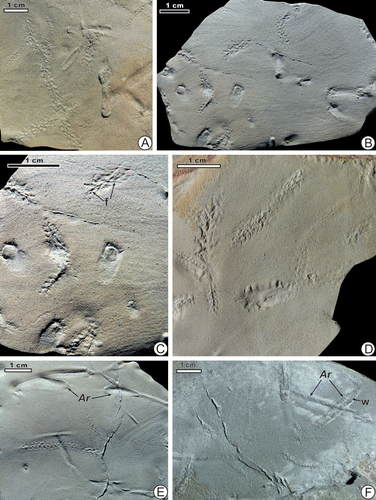Figures & data
Figure 1. Location maps. (A) General location of the study region and the study area. (B) Generalised section of the Mezardere Formation in the middle part of the island with approximate stratigraphic location of the outcrop partial sections (for reference numbers see Table ). (C) Geological map of the Gökçeada Island (modified from Temel & Çiftçi, Citation2002) showing locations of studied outcrops (for reference numbers see Table ).
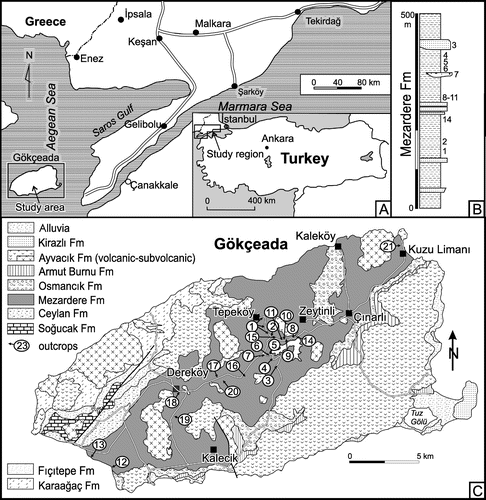
Figure 2. Stratigraphic column of the units on Gökçeada Island (modified from Temel & Çiftçi, Citation2002, foremost in respect to the lithology of the Mezardere Formation).
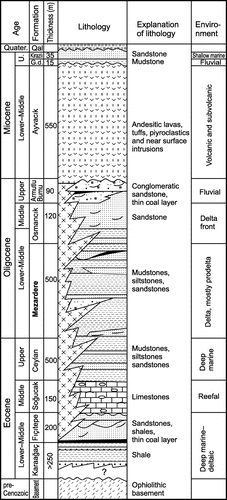
Figure 3. Outcrop photographs illustrating facies of the Mezardere Formation. For outcrop numbers see Table . (A). Slightly metamorphosed mudstone shales intercalated with rippled, very fine-grained sandstones and siltstones of the prodelta facies, outcrop 8. (B) Prodelta facies dominated by mudstones; outcrop 19, about 20 m high. (C). Mudstones intercalated with fine-grained sandstones, prodelta facies; adjacent to outcrop 1. (D) Thickening- and coarsening-up package of sandstones intercalated with mudstones, which overlies mudstones; distal mouth bar facies overlying prodelta facies; outcrop 1; 1 m long measurement stick for scale in the red ellipse. (E) Isolated packages of thin-bedded sandstones in prodelta mudstones, probably very distal mouth bars; outcrop 20; the package of sandstone beds in the middle is about a metre thick. (F) Cross-bedded lenticular lithosoms of sandstones; proximal mouth bar facies; outcrop 16, about 20 m high.
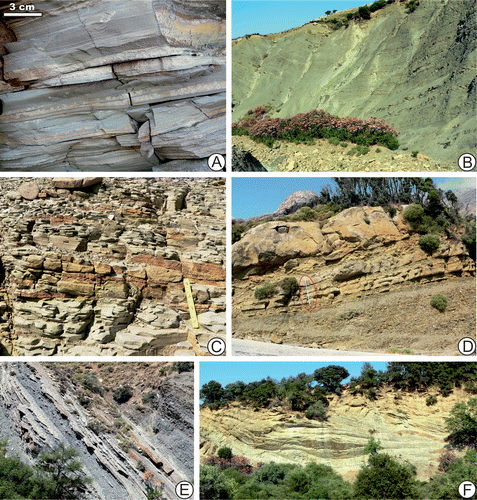
Table 1. The studied outcrops of the Mezardere Formation in the Gökçeada Island.
Figure 4. Photographs of beddings planes illustrating trace fossils in the Mezardere Formation. (A) Archaeonassa cf. fossulata, outcrop 3, specimen TRGM3/01. (B) Archaeonassa cf. fossulata, small form, outcrop 4, specimen TRGM1/01. (C) Archaeonassa isp. A, outcrop 4, specimen TRGM1/02. (D) Archaeonassa isp. B showing oblique marks (om); outcrop 4, specimen TRGM1/03. (E) ?Arenicolites isp., presumable pairs of structures related to limbs are in yellow ellipses; outcrop 21, specimen TRGM8/01. (F) ?Arenicolites isp., outcrop 3, specimen TRGM1/04. (G) Bichordites kuzunensis, outcrop 21, specimen INGUJ224P7. (H) ?Copeza isp., outcrop 7, specimen TRGM7/01. (I) G. indianensis, a specimen with short protrusions (p); outcrop 7, specimen TRGM6/01.
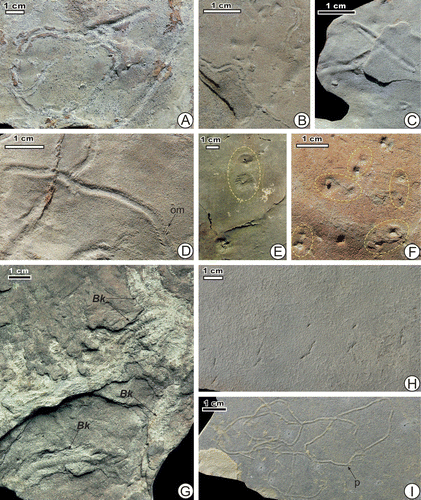
Figure 5. Trace fossils of the Mezardere Formation. (A) ?Hamipes isp., outcrop 6, specimen TRGM7/02. (B) G. indianensis, outcrop 5, specimen TRGM5/01. (C) cf. Halimedides isp. (Hd) and Ptychoplasma isp. (Pt), outcrop 4, specimen TRGM1/05. (D) Helminthoidichnites isp., outcrop 5, specimen TRGM5/02. (E) Helminthoidichnites isp. on a rippled surface; outcrop 6, specimen TRGM1/06. (F) Helminthoidichnites isp., outcrop 5, specimen TRGM1/07. (G) Helminthoidichnites cf. ornatus, outcrop 8, specimen TRGM8/02. (H) Helminthoidichnites cf. ornatus, outcrop 6, specimen TRGM8/03.
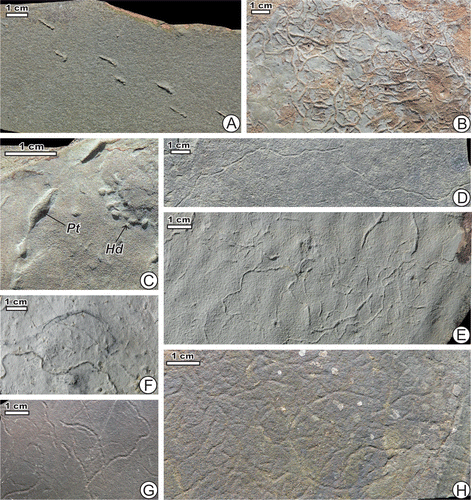
Figure 6. More trace fossils of the Mezardere Formation. (A), (B) Osculichnus cf. labialis, outcrop 4, specimen TRGM1/08. (C) P. tubularis, outcrop 1, specimen TRGM2/01. (D) P. beverleyensis, outcrop 8, specimen TRGM1/09. (E) P. montanus (Pl) and small burrows (sb), outcrop 12, specimen TRGM12/01. (F) P. montanus (Pl) and small burrows (sb), outcrop 1. (G) Ptychoplasma isp., outcrop 1, specimen TRGM12/02. (H) Treptichnus cf. apsorum, outcrop 7, specimen TRGM4/01. (I) Treptichnus cf. apsorum, outcrop 8, specimen TRGM4/02. (J) Treptichnus cf. apsorum, outcrop 4, specimen TRGM4/03. (K) Treptichnus cf. apsorum, outcrop 8, specimen TRGM4/04. (L) ?Treptichnus isp., outcrop 2, specimen TRGM12/03.
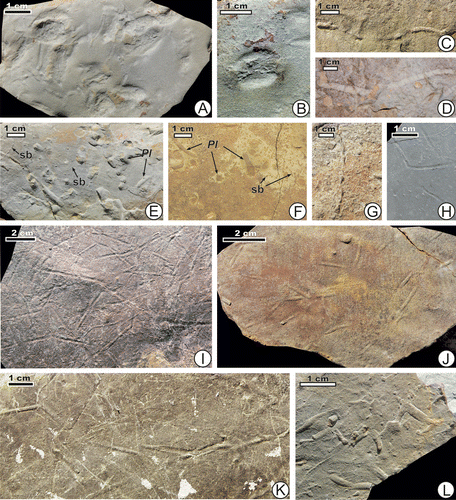
Figure 7. ?Undichna isp., outcrop 8. (A) Plate with ?Undichna isp., and Helminthoidichnites cf. ornatus (upper left detail in Figure (G)) and Helminthoidichnites isp, specimen TRGM8/02. (B) The same plate with ?Undichna isp. traced by lines, specimen TRGM8/02.
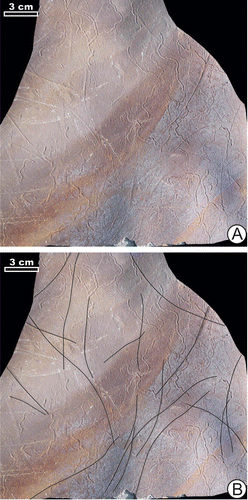
Figure 8. Some arthropod trace fossils from Mezardere Formation, outcrop 4. (A) Arthropod trackways, specimen TRGM1/10. (B) Resting traces, specimen TRGM1/10. (C) Detail of B, with indication of examples of oblique furrows (f) inclined in opposite direction in respect to the longer trace axis, specimen TRGM1/10. (D) Resting traces. (E), (F) Arthropod trackways and Archaeonassa isp. A (Ar), including specimen showing irregular wrinkles (w), specimen TRGM1/10.
